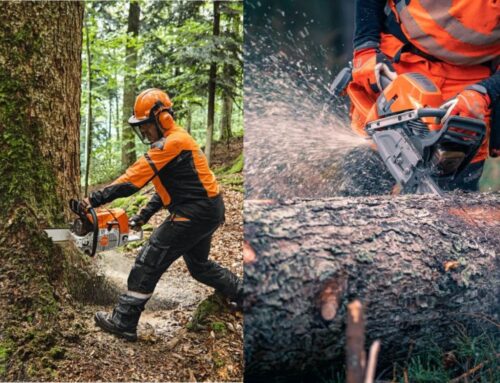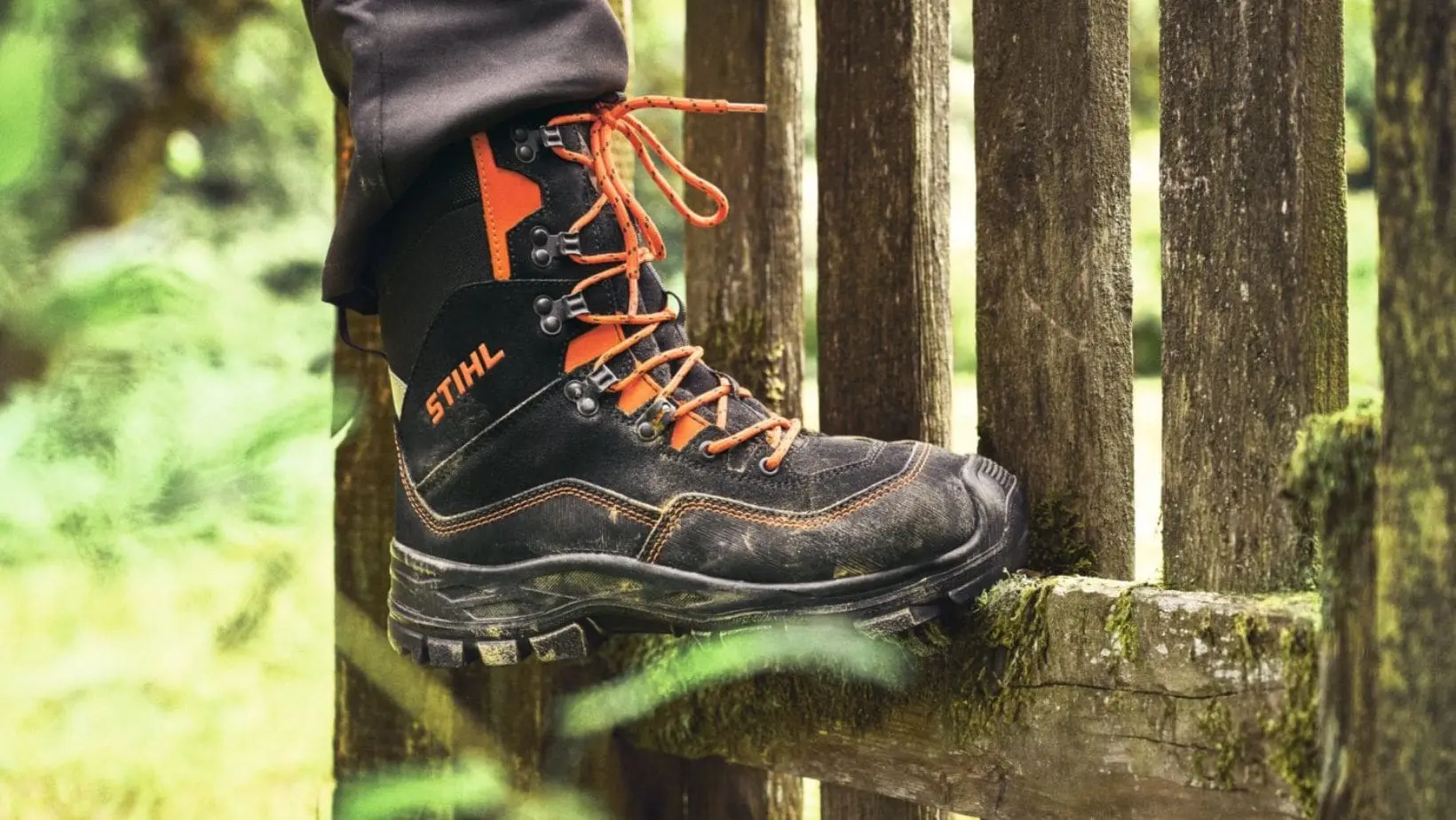
Our Essential Guide to Choosing the Best Chainsaw Boots
If you’re working with a saw, every step needs to be confident, stable, and protected. The right chainsaw boots don’t just keep your feet dry; they add certified cut resistance, impact protection, and reliable grip when the ground is slick with rain, sap, or mud. In this guide, we reveal all you need to know to make an informed decision when choosing the best chainsaw boots for your work. We’ll explain the different protection classes; show you trusted examples of each class of boot; compare leather, synthetic and rubber materials; and outline the other key features worth caring about.
 Why Chainsaw Boots Are Different
Why Chainsaw Boots Are Different
Chainsaw safety boots are purpose-built for working with saws, combining the core safety footwear standard EN ISO 20345 with specialist cut-resistance verified to EN 381 and BS EN ISO 17249. Inside the boot, layers of high-tenacity fibres are designed to pull into the chain and slow it rapidly on contact. Of course, no item of PPE can guarantee absolute safety, yet properly certified chainsaw protective boots markedly reduce risk and form a crucial part of your complete PPE, alongside trousers, gloves, eye and ear protection, and safe working practices. For foresters, landscapers, and arborists, the difference compared with ordinary work boots is significant: more protection where it counts, in a package still comfortable enough for long working days.
Understanding Chainsaw Boot Classes
Cut-protection classes align to the maximum chain speed the boot is tested against: Class 0 up to 16 m/s, Class 1 up to 20 m/s, Class 2 up to 24 m/s, and Class 3 up to 28 m/s. As protection rises, additional layers tend to add structure and a little more weight, though modern materials have improved comfort dramatically. Choose the class that matches your saws, your tasks, and the conditions you face; that way you wear enough protection without feeling overbuilt for the job.
Class 1: Everyday Professional Protection (up to 20 m/s)
Class 1 remains the most common level for routine forestry tasks and serious domestic use, striking a fine balance between mobility and cut resistance. It’s typically the best starting point for operators who split their time between different chainsaw tasks across mixed conditions.
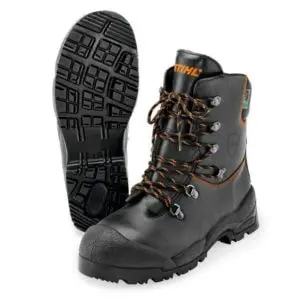 STIHL Function Leather Chainsaw Boots (Class 1)
STIHL Function Leather Chainsaw Boots (Class 1)
These leather chainsaw boots are a textbook Class 1 choice for demanding home users and professionals who value durability with all-day comfort. Built from water-retardant full-grain leather, they pair a classic upper with a breathable textile lining to regulate temperature on long shifts. A steel toe cap provides essential impact protection; the treaded, self-cleaning sole maintains grip on wet grass and muddy rides; and the lower-rise leg works well for those with larger calves. Despite these boots’ robust spec, the overall feel is lighter than you’d expect, which makes them suitable for varied groundwork where you’re on your feet for hours. These STIHL chainsaw boots are a dependable all-rounder, being fully certified and offering genuine value for money.
Find out more about these STIHL chainsaw boots here.
Class 2: Extra Protection for Tougher Tasks (up to 24 m/s)
If you’re regularly running larger saws, processing heavier timber, or simply want an additional safety margin, Class 2 brings that useful overhead while remaining manageable for full days on the ground. This class of boots is typically the norm for trained arborists and foresters.
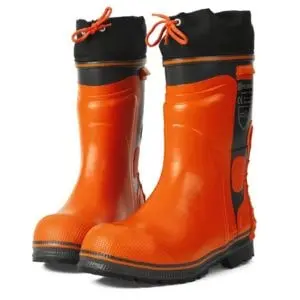 Husqvarna Functional 24 Rubber Chainsaw Boots (Class 2)
Husqvarna Functional 24 Rubber Chainsaw Boots (Class 2)
These Husqvarna chainsaw boots demonstrate how a Wellington design can deliver serious protection and year-round practicality. Constructed from robust, waterproof natural rubber, with reinforced soles and sturdy steel toe caps, they offer excellent impact resistance. The deep, self-cleaning tread keeps moving through mud, leaf litter, and churned sites, while the cotton canvas lining helps wick moisture away to improve comfort when you’re out for hours. Many foresters prefer this style of boot through wet winters because it hoses clean at the end of the day and shrugs off persistent rain. If you need forestry boots capable of coping with punishing terrain and providing high-quality protection, these chainsaw Wellington boots are a really smart pick.
Learn more about these Husqvarna safety boots now.
Class 3: Maximum Protection for Demanding Professional Use (up to 28 m/s)
Class 3 sits at the top of the scale and is the correct choice for high-risk environments, storm damage work, large timber, or any operation where protection simply cannot be compromised.
 STIHL Special Rubber Chainsaw Boots (Class 3)
STIHL Special Rubber Chainsaw Boots (Class 3)
These Class 3 STIHL boots are built for the sharp end of forestry and arboriculture. Handmade from durable natural rubber, they combine a steel toe cap with a cut-resistant package rated to 28 m/s, along with rugged, self-cleaning soles that maintain traction on wet banks and slick timber. Adjustable leg cuffs seal out debris and water, while reflective bands improve visibility around vehicles and machinery. These forestry boots are also compatible with climbing spikes—an absolute must for anyone working at height. Despite their heavy-duty brief they’re by no means cumbersome, with a flexible rubber body that reduces wearer fatigue over long sessions. If you need chainsaw safety boots at the highest protection level, this model ticks all the right boxes for the toughest work.
Discover more about these premium STIHL chainsaw boots here.
Matching the Class to Your Work
To summarise, for firewood processing, occasional storm clean-ups, and mixed ground tasks at moderate chain speeds, Class 1 chainsaw boots are usually ideal. Arborist teams tackling heavier workloads, running larger saws daily, or operating in challenging terrain benefit from Class 2’s extra margin. Where you’re consistently working big timber, dealing with complex fells, or operating in high-risk environments, Class 3 delivers the correct level of protection. Any certified protection is far better than none, but choosing the correct class gives you the best safety margin for the tools and techniques you use.
Leather, Synthetic, or Rubber: Which Upper Suits Your Work?
Material choice has a major influence on comfort, durability, and maintenance.
Leather Chainsaw Boots
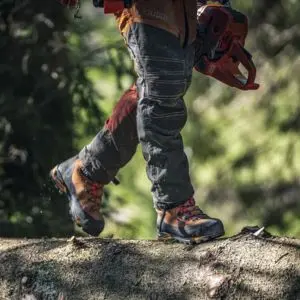 Traditional leather chainsaw boots remain a trusted option for forestry safety boots thanks to their toughness, natural water resistance, and ability to mould to your feet. There is usually a short break-in, and they can be a touch heavier than some synthetic-panelled designs, yet the payoff is longevity and a traditional fit that many professionals prefer.
Traditional leather chainsaw boots remain a trusted option for forestry safety boots thanks to their toughness, natural water resistance, and ability to mould to your feet. There is usually a short break-in, and they can be a touch heavier than some synthetic-panelled designs, yet the payoff is longevity and a traditional fit that many professionals prefer.
Synthetic Boots
This type of material is often integrated into newer arborist boots, bringing lighter weight and improved breathability. If you prioritise nimble movement for climbing and aerial work, these lightweight chainsaw boots can feel more athletic, drying faster after rain and needing less upkeep. Durability varies across fabrics and construction styles, so it’s worth choosing a reputable brand and checking the stitching plus reinforcements.
Rubber Chainsaw Boots
Chainsaw Wellington boots have a particular appeal in the British climate. They offer total waterproofing, deep tread, and easy hose-down cleaning. They won’t breathe like textile-lined leather or synthetic shells, yet for long, wet winters and boggy ground, rubber remains a practical, hard-wearing choice. Professional teams often keep a rubber pair of chainsaw boots for the worst of the weather and switch to leather or synthetic in drier spells.
Comfort and Fit: Your Key Safety Foundation
 Footwear that fits well is safer because you move naturally, place your feet accurately, and stay fresher for longer. Aim for a locked-in heel with space at the toes to avoid bruising on descents. Check the midfoot doesn’t let you roll about over brash and roots. All the top brands carry extensive sizing—guaranteeing a precise fit for both men’s chainsaw boots and ladies chainsaw boots. Insoles can fine-tune volume, and the right socks make a noticeable difference across the seasons. If you’re upgrading from older, heavier styles, you may be surprised how effectively modern chainsaw shoes and boots combine A1 protection with an agile feel underfoot.
Footwear that fits well is safer because you move naturally, place your feet accurately, and stay fresher for longer. Aim for a locked-in heel with space at the toes to avoid bruising on descents. Check the midfoot doesn’t let you roll about over brash and roots. All the top brands carry extensive sizing—guaranteeing a precise fit for both men’s chainsaw boots and ladies chainsaw boots. Insoles can fine-tune volume, and the right socks make a noticeable difference across the seasons. If you’re upgrading from older, heavier styles, you may be surprised how effectively modern chainsaw shoes and boots combine A1 protection with an agile feel underfoot.
Other Features That Matter
Steel toe caps are standard across certified models, guarding against falling rounds and knocks in tight brash piles. Some boots add puncture-resistant midsoles to reduce underfoot risk from nails, thorns, and hard stubs on extraction tracks. Outsoles should be oil- and slip-resistant with a tread that sheds mud readily, while self-cleaning designs prove their worth on clay where conventional patterns clog quickly. For wet ground and persistent showers, look for sealed seams and waterproof constructions; leather can be re-proofed periodically, synthetic shells rely on membranes, and rubber Wellingtons give total barrier protection.
 Inside the boot, breathable linings and cushioned footbeds ease pressure over long working days. Collars and tongues with sensible padding limit rub points, while lacing systems and adjustable cuffs help you dial in the fit. If climbing is on the cards, confirm compatibility with spikes. Reflective accents add a small but meaningful visibility boost at dawn, dusk, or on roadside sites.
Inside the boot, breathable linings and cushioned footbeds ease pressure over long working days. Collars and tongues with sensible padding limit rub points, while lacing systems and adjustable cuffs help you dial in the fit. If climbing is on the cards, confirm compatibility with spikes. Reflective accents add a small but meaningful visibility boost at dawn, dusk, or on roadside sites.
Finally, check the label: EN 381 (forestry protection) and BS EN ISO 17249 for cut-resistant footwear, plus EN ISO 20345 for core PPE footwear safety standards. These marks help you compare like-for-like when you see chainsaw boots for sale at different prices. If you’re looking for a pair of cheap chainsaw boots, certification should never be the compromise.
Making the Right Purchase
 As there’s a broad spread of pricing, it’s natural to look for value. Even if you’re tempted by some chainsaw boots’ cheap pricing, still prioritise certification and sound construction over the very lowest ticket. Previous-season models from trusted brands can offer real savings. Think about the upper style you prefer and the conditions you face most often. Leather chainsaw boots excel for support and longevity; synthetic-panelled designs lead on low weight and quick drying; and rubber boots thrive in relentless wet weather. When in doubt, try on multiple styles to compare flex, volume, and heel hold.
As there’s a broad spread of pricing, it’s natural to look for value. Even if you’re tempted by some chainsaw boots’ cheap pricing, still prioritise certification and sound construction over the very lowest ticket. Previous-season models from trusted brands can offer real savings. Think about the upper style you prefer and the conditions you face most often. Leather chainsaw boots excel for support and longevity; synthetic-panelled designs lead on low weight and quick drying; and rubber boots thrive in relentless wet weather. When in doubt, try on multiple styles to compare flex, volume, and heel hold.
Care, Maintenance, and Replacement
Once you’ve bought a pair of chainsaw boots, you’ll obviously want to look after them. So, brush off grit after each use, rinse mud before it hardens, and dry the boots away from direct heat to protect adhesives and leather. Treat leather periodically with a suitable conditioner to maintain water resistance and flexibility. Check for deep cuts, delamination, and crushed toe caps; if structural protection is compromised, it’s time to get a new pair. Well-maintained chainsaw boots last longer, perform better, and give you more value over the season.
Ready to Step Into the Right Boots?
 At Garden Machinery Direct, you’ll find a carefully selected range of chainsaw boots across all protection classes, from everyday Class 1 all-rounders to specialist Class 3 options. We sell both STIHL chainsaw boots and Husqvarna safety boots in all the available sizes. And if you’re searching online for ‘chainsaw boots near me’, our efficient nationwide delivery service will bring them to your door.
At Garden Machinery Direct, you’ll find a carefully selected range of chainsaw boots across all protection classes, from everyday Class 1 all-rounders to specialist Class 3 options. We sell both STIHL chainsaw boots and Husqvarna safety boots in all the available sizes. And if you’re searching online for ‘chainsaw boots near me’, our efficient nationwide delivery service will bring them to your door.
If you’re torn between leather, synthetic, and rubber, or want guidance on the most appropriate class for your saws and sites, our expert team is always on-hand to help.
We work closely with arborists, foresters, and landscapers across the UK, and understand how boots behave in real-world conditions. Tell us about your workload, preferred fit, and budget, and we’ll point you towards the best chainsaw boots for your needs. We’ll give you honest advice on the models in stock, fair pricing on chainsaw boots for sale, and practical aftercare tips to keep your kit performing.

